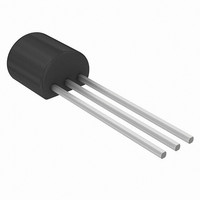AD592CNZ Analog Devices Inc, AD592CNZ Datasheet - Page 7

AD592CNZ
Manufacturer Part Number
AD592CNZ
Description
IC TEMP TRANSDUCER 2-TERM TO92-3
Manufacturer
Analog Devices Inc
Specifications of AD592CNZ
Sensing Temperature
-25°C ~ 105°C
Output Type
Current
Voltage - Supply
4 V ~ 30 V
Accuracy
±0.3°C
Package / Case
TO-226-3, TO-92-3 (TO-226AA)
Ic Output Type
Current
Sensing Accuracy Range
± 0.3°C
Supply Voltage Range
4V To 30V
Sensor Case Style
TO-92
No. Of Pins
3
Termination Type
Through Hole
Mounting Type
Through Hole
Temperature Sensor Function
Temp Sensor
Package Type
TO-92
Operating Temperature (min)
-25C
Operating Temperature Classification
Commercial
Operating Supply Voltage (min)
4V
Operating Supply Voltage (typ)
5/9/12/15/18/24V
Operating Supply Voltage (max)
30V
Body Style
TO-92
Current, Switching
298.2 μA
Function
Temperature
Output
Current
Primary Type
Temperature
Range, Measurement
105 °C
Termination
3-Wire Connector
Voltage, Supply
30 V
Filter Terminals
Through Hole
Rohs Compliant
Yes
Lead Free Status / RoHS Status
Lead free / RoHS Compliant
Lead Free Status / RoHS Status
Lead free / RoHS Compliant, Lead free / RoHS Compliant
The circuit shown can be optimized for any ambient tempera-
ture range or thermocouple type by simply selecting the correct
value for the scaling resistor – R. The AD592 output (1 A/K)
times R should approximate the line best fit to the thermocouple
curve (slope in V/ C) over the most likely ambient temperature
range. Additionally, the output sensitivity can be chosen by
selecting the resistors R
gain. The offset adjustment shown simply references the AD592
to C. Note that the TC’s of the reference and the resistors are
the primary contributors to error. Temperature rejection of 40
to 1 can be easily achieved using the above technique.
Although the AD592 offers a noise immune current output, it is
not compatible with process control/industrial automation cur-
rent loop standards. Figure 12 is an example of a temperature to
4–20 mA transmitter for use with 40 V, 1 k systems.
In this circuit the 1 A/K output of the AD592 is amplified to
1 mA/ C and offset so that 4 mA is equivalent to 17 C and
20 mA is equivalent to 33 C. Rt is trimmed for proper reading
at an intermediate reference temperature. With a suitable choice
of resistors, any temperature range within the operating limits of
the AD592 may be chosen.
Reading temperature with an AD592 in a microprocessor based
system can be implemented with the circuit shown in Figure 13.
REV. A
AD592
AD592
Figure 12. Temperature to 4–20 mA Current Transmitter
AD581
SPAN
TRIM
Figure 13. Temperature to Digital Output
100
950
10mV/
C
200
o
9k
1k
G1
C
AD1403
35.7k
10k
and R
5k
R
CENTER
POINT
TRIM
T
12.7k
10
G2
208
for the desired noninverting
V
V
V
V
I
I
I
17 C
33 C
N
N
FORMAT
IN HI
N
LO
LO
HI
R/W
5k
4mA
20µA
BPO/UPO
µP CONTROL
ADCPORT
AD670
CS
500
1mA/
+5V
V
V
CE
o
CC
C
T
GND
+20V
–20V
8 BITS
OUT
–7–
By using a differential input A/D converter and choosing the
current to voltage conversion resistor correctly, any range of
temperatures (up to the 130 C span the AD592 is rated for)
centered at any point can be measured using a minimal number
of components. In this configuration the system will resolve up
to 1 C.
A variable temperature controlling thermostat can easily be built
using the AD592 in the circuit of Figure 14.
R
by the potentiometer R
full temperature range (–25 C to +105 C) the AD592 is rated
for. The reference maintains a constant set point voltage and
insures that approximately 7 V appears across the sensor. If it is
necessary to guardband for extraneous noise hysteresis can be
added by tying a resistor from the output to the ungrounded
end of R
Multiple remote temperatures can be measured using several
AD592s with a CMOS multiplexer or a series of 5 V logic gates
because of the device’s current-mode output and supply-voltage
compliance range. The on-resistance of a FET switch or output
impedance of a gate will not affect the accuracy, as long as 4 V
is maintained across the transducer. MUXs and logic driving
circuits should be chosen to minimize leakage current related
errors. Figure 15 illustrates a locally controlled MUX switching
the signal current from several remote AD592s. CMOS or TTL
gates can also be used to switch the AD592 supply voltages,
with the multiplexed signal being transmitted over a single
twisted pair to the load.
HIGH
T
8
AD592
and R
Figure 14. Variable Temperature Thermostat
Figure 15. Remote Temperature Multiplexing
LOW.
10k
T
2
LOW
determine the limits of temperature controlled
T
1
C
+15V
SET
REMOTE
AD592s
AD581
62.7k
27.3k
R
R
10k
R
. The circuit shown operates over the
HIGH
LOW
SET
S1
S2
S8
COMPARATOR
AD7501
R
HYST
C
+15V
TTL DTL TO
CMOS I/O
E
N
CHANNEL
SELECT
(OPTIONAL)
–15V
D
E
C
O
D
E
R
TEMP > SETPOINT
OUTPUT HIGH
TEMP < SETPOINT
OUTPUT LOW
R
/
PULL-UP
D
R
V
E
R
I
AD592
10k
V
OUT









